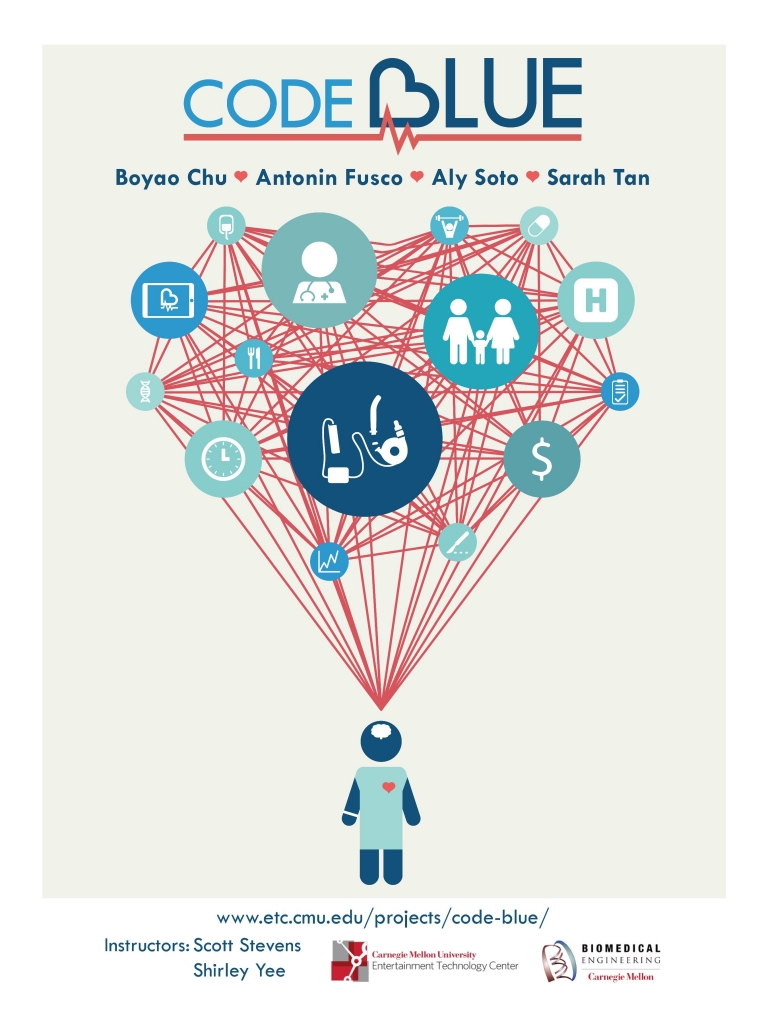 Code Blue is a cross-disciplinary collaboration between Carnegie Mellon’s Biomedical Engineering department and the Entertainment Technology Center.
Code Blue is a cross-disciplinary collaboration between Carnegie Mellon’s Biomedical Engineering department and the Entertainment Technology Center.
With medicine’s ever expanding array of life-prolonging technologies, older and sicker people are increasingly offered invasive interventions. However, these interventions are often life-saving, and have the power to improve the patient’s quality of life. The cutting-edge left ventricular assist device (LVAD) can do such for patients with end stage heart failure. It even has the potential to extend their life expectancy.
The LVAD is a mechanical pump, surgically implanted and attached to the heart. Unlike an artificial heart (which replaces the failing organ), the LVAD helps to pump blood throughout the body and reduce the work load needed to do it. As the name “Left Ventricular Assist Device” suggests, it does this by taking the blood from the left ventricle and moves it to the aorta. The aorta then delivers the blood forward.
This machine has parts that sit both inside and outside the body. The pump itself is located on or next to the left ventricle of the heart with a tube that moves the blood to the aorta. A driveline (power cable) connects the pump through the skin to a controller and re-chargeable battery outside. Both the controller and battery are carried by the person with the LVAD and everything must be connected at all times.
The LVAD can be used as either an aid to help carry the patient over until a heart donor is found, or as a permanent intervention for patients who either too old or sick (thus making them ineligible) for a heart transplant.
The Problem
As one can imagine, the medical and ethical decisions involved with electing to have the surgery can be scary and complicated for patients and their loved ones.
“It is a major open heart surgery. A mechanical device is being attached to your heart. You have a hole that goes inside to outside of you for maybe the rest of your life. The chance of infection is high. The chance of stroke is high. There’s a lot of changes in lifestyle. So it’s a good idea for some people and it’s not for others.” – Lisa Lohmueller, Project Coordinator
It doesn’t help matters much that every single LVAD decision aid out there is industry sponsored, biased towards getting an LVAD and fails the International Patient Decision Aid Standards.
Our client wants to fix this.
What has been done already?
 Researchers at the University of Colorado Denver (whom Code Blue and our client are working with) have created and are currently testing a non-industry sponsored LVAD decision aid in video format.
Researchers at the University of Colorado Denver (whom Code Blue and our client are working with) have created and are currently testing a non-industry sponsored LVAD decision aid in video format.
This video includes:
- Info about the LVAD and how it operates
- How an LVAD could potentially improve one’s quality of life
- How the device would change one’s daily activities
- What one’s caretaker needs to know
- Patient testimonials covering…
- Those who decided to go with the surgery and were happy
- Those who decided to go with the surgery and weren’t happy
- Those who decided to not go with the surgery at all
While this video is a great start, it’s not being presented in a format that’s easily navigable by the specific target audience of end-stage heart failure patients our client is working on: senior citizens and their caregivers (usually a loved one such as a spouse or adult child).
What is Code Blue doing?
Code Blue is working this semester to build a decision aid platform that our client can use in his research and eventual real-life implementation. Our client plans for this decision aid to be displayed on electronic tablets that doctors will give to patients to take home with them and look over before coming back to them. It will also be built to function alongside a prognostic tool website, myCORA (Cardiac Outcome Risks Assessment), that our client has been helping to develop. Formatting it as a web app allows for easy access in different locations should the caregiver not be in the same place as the patient.
Our final product will include:
- A Hypertext FAQ
- If patients don’t have any questions or goals coming into the app, they can simply click the hypertext and will be directed to a video clip or text that answers it
- This will also allow for a system that allows who ever is managing the app’s content to add new content and remove irrelevant information
- A Searchable Video Library
- Should a patient come into this app with questions in mind, they can type them in and will then be directed to a list of video clips that could potentially answer their question
- Additionally, if the patient doesn’t see the answer to their question, they’ll have the option of contacting the app’s content managers with their query. This allows for easy monitoring of what type of content needs to be added to keep the app relevant and useful
- Personalization
- The myCORA website includes tools that help doctors explore the prognosis of their patients. These same tools will be re-imagined so that each patient can look at the same data as it applies to them. Additionally, they’ll be able to view their diagnosis, doctor, and hospital information. All of this is useful to have on hand when making this decision.
- Patient Responses
- A system to record how much information the user has retained after using the app

Recent Comments